By: Bjørn Lomborg – nationalreview.com –
The global discussion about climate change has become quite hysterical. Some 60 percent of people living in the rich world think it is likely to bring an end to humanity. This is not only untrue; it is also harmful, because fear makes people embrace bad policies and ignore many other urgent challenges facing the world. Consider, for example, how the World Health Organization declared climate change the defining public-health issue of the 21st century in 2014, but perhaps should have been more focused on pandemics, like Covid. Or take the World Economic Forum participants who in January 2020 found the greatest policy risk of the next ten years to be climate-action failure — ignoring the rapid spread of Covid. Or consider how development institutions increasingly focus on helping poor countries with climate-change responses, often at the expense of other things those countries urgently need, such as growth and development, stronger health-care systems, better education, and a more plentiful energy supply.
Climate change is a real and man-made phenomenon, and it will have negative impacts overall. That’s a fact, and it is one that we hear a lot. The “catastrophe narrative,” however, is drowning out many other relevant facts about climate change — for example, that 98 percent fewer people are dying from climate-related disasters today than did a century ago, and that net-zero-emission policies are eye-wateringly costly. The following are eight charts that I think more people should see, to understand that the climate-change data are very different from what we hear in the commonplace narrative.
1. Hurricanes
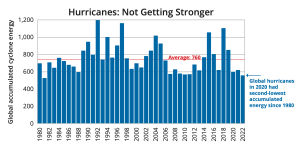
These days, every weather phenomenon is turned into instant climate news, with smartphone cameras immediately sharing pictures of the damage and campaigners blaming climate change for it all. Hurricanes are a key part of this narrative. But that does not mean hurricanes are actually battering our coasts any more frequently than before, as is often implied or stated outright.
Indeed, the hurricanes of 2022 were close to unprecedented — but only in their weakness. Globally, 2022 had the second-weakest batch of hurricanes in the era of satellite data (beginning in 1980). It also had the fourth-fewest strong hurricanes (category 3 and above) in the same period and the eighth-fewest hurricanes overall. Moreover, despite what we hear, hurricanes have not been getting stronger globally. The average energy per hurricane has remained constant in the satellite era.
The same is true if we focus on the United States. Contrary to what is commonly asserted, the frequency of hurricanes hitting the continental U.S. has notincreased over the past 122 years. The best-fit line actually trends slightly downward. (Counting landfall hurricanes is the most consistent way of having a measure that goes back to 1900, whereas the number of named hurricanes — which includes those that do not hit land — steadily increases because we have ever-better technologies to detect even very short-lived hurricanes.)
The U.N. Climate Panel expects that climate change will increase the global proportion of strong hurricanes by 10 to 20 percent, while the total number of hurricanes will remain constant or fall. This will make damages worse overall than if there were no climate change — a legitimate example of global warming having a net harmful impact. But it is important to keep a sense of proportion.
Today, hurricanes around the world cause damage each year worth 0.04 percent of global GDP. And because the world will be much richer in the future, there will be more property to damage. But richer societies are also more resilient and better able to protect lives and assets. Taking all these factors into account, without climate change, annual hurricane damage would decline to 0.01 percent of global GDP by 2100, as estimated in a highly cited Nature study. But because climate change will increase the proportion of the worst hurricanes, damages with climate change will instead cost 0.02 percent of GDP. In other words, the world will get better (with lower damages than at present from hurricanes as a share of GDP), but climate change will slow down this progress.
2. Heat and Cold
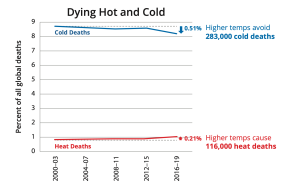
One of the most publicized effects of climate change is deaths caused by rising temperatures, especially during heat waves. Every summer we see the media in Europe and North America seize upon spikes in temperature to warn about the urgent need to tackle climate change.
What we rarely hear is that cold also kills — and it kills many more. A July 2021 study in the Lancet, Britain’s premier medical journal, showed that heat currently causes just over 1 percent of all global deaths, or almost 600,000 each year. Cold kills eight times as many — about 4.5 million people annually. Cold deaths are more frequent not just in cold areas but, surprisingly, across the world. (Even the climate-alarmed Washington Post grudgingly accepts this.) Cold kills mainly because it makes blood vessels constrict to direct more heat to the body’s core organs, driving up blood pressure and increasing risks for strokes and heart attacks.
As temperatures rise, cold will kill fewer people. The Lancet estimates that the observed temperature rise over the past two decades has increased heat deaths by 0.21 percent but decreased cold deaths by 0.51 percent. With the current population, that change means that global warming actually prevents 166,000 temperature-related deaths every year. Had we stopped global warming two decades ago, more people today would be dying from the temperature.
Deaths from both heat and cold need our attention. For heat, adaptation is fairly simple with better information, plenty of fluids, and access to cool areas during the peak days. This is why heat deaths in rich countries — despite climate change — have generally declined in recent decades: Air-conditioning is a relatively affordable option.
Cold is much harder to tackle, since adaptation requires heating homes for months, which is often prohibitively expensive for poorer households. One study shows that when fracking drove down U.S. natural-gas prices around 2010, it allowed poorer households especially to be better heated, saving an estimated 11,000 lives each year.
In summary, to address both heat and cold, we need access to plentiful and cheap energy — the opposite of what many climate policies would achieve.
3. Polar Bears
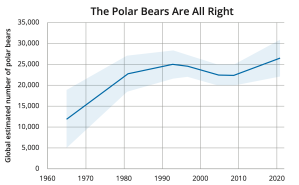
Climate activists have long used polar bears as an iconic image of looming apocalypse, as when Al Gore’s influential film An Inconvenient Truth showed a sad animated polar bear floating away to its death, or when the Washington Postin 2004, citing alarmist statements from the World Wildlife Fund, claimed that polar bears could face extinction.
The best data on polar-bear populations come from the official assessments of polar-bear-specialist scientists. They estimate the global population today is somewhere between 22,000 and 31,000, clearly higher than the 12,000 they estimated in the 1960s. Even the newest data, referenced in the latest report from polar-bear-specialist researchers, show that polar-bear numbers are increasing, not decreasing.
These facts used to be uncontroversial. In 2008, a CNN science journalist who interviewed numerous polar-bear scientists found that all “agree[d] that polar-bear populations have, in all likelihood, increased in the past several decades.” In recent years, however, major media outlets, including AFP, have started “fact-checking” those (like me) who point out that the number of polar bears is rising. What changed? The media’s new willingness to disregard facts in favor of a simplistic narrative about climate change, now disingenuously suggesting that we’ve never really known what the right number of polar bears was, and therefore we can’t say if there are more, whereas previously they acknowledged that of course polar-bear numbers had risen.
We should remember that polar bears survived the last interglacial period, 130,000 to 115,000 years ago, when it was significantly warmer than it is now. But the bigger point is this: Numbers are up because the polar bear used to be heavily hunted. Beginning in 1976, a partial hunting ban protected the bears better, and the populations recovered. Indeed, hunting has always been the main threat to the polar bear, and protection is pivotal. If we care about polar bears, it is hunting that we should focus on.
4. Fire
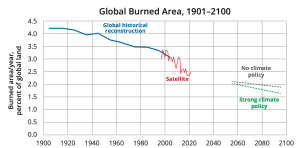
We can add wildfires to the list of natural disasters that are overhyped in climate coverage. Back in the early 1900s, about 4.2 percent of land worldwide burned every year. A century later, that figure had dropped to almost 3 percent. The decline has continued through the modern era, with satellites measuring burn across the globe every day. These data are entirely uncontroversial. Even a report from the World Wildlife Fund — chillingly subtitled “A Crisis Raging out of Control?” — concedes that “the area of land burned globally has actually been steadily declining since it started to be recorded in 1900.”
Human ingenuity gets the credit for the decrease: People have moved fire from hearths to power stations, converted untamed land into protected farms, and become well-off enough to afford fire suppression and forest management. Climate studies that predict significantly more fires typically ignore this history. They model only temperature changes, excluding what people might do in response. Conditions conducive to wildfires will indeed become more common as temperatures continue to rise. But that doesn’t mean people will idly let it happen — and when models factor in predicted human adaptation, such as controlled burning, these increases in fire damage disappear.
To be sure, more people will probably be threatened by fires in the future, and more are threatened now than in the past. But this is not a result of climate change. It is because part of the world’s growing population chooses to settle where wildfires are more common. The number of homes in high-fire-risk zones in the western U.S. has increased thirteenfold over the past 80 years and is set to increase further by 2050. A 2016 Nature study finds this trend to be global: “Contrary to common perception, human exposure to wildfires increases in the future mainly owing to projected population growth in areas with frequent wildfires, rather than by a general increase in burned area.”
Decreasing future wildfire victims has very little to do with climate-change policies and almost everything to do with simpler, cheaper measures, such as improving forest management, enforcing stricter zoning, making neighborhoods more resilient, and strengthening building codes so that fewer people are in harm’s way.
5. Not What Matters for Malnutrition
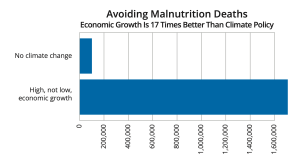
The World Health Organization has warned that climate change will cause an additional 250,000 deaths each year in the two decades following 2030, with 95,000 of them due to malnutrition. This sounds alarming, but it misleads.
The WHO’s numbers come from comparing the actual world with an imaginary one in which there is no climate change, and calculating the difference between them in the number of deaths from malnutrition, malaria, diarrhea, dengue fever, flooding, and heat (they ignore cold deaths).
In fact, malnutrition deaths are forecast to decline rapidly over the next three decades, in part because of increasing crop yields. Admittedly, climate change makes these yields increase slightly more slowly; according to the WHO, the difference in 2030 will be 95,000 additional deaths. But there are more factors involved, going beyond crop yields. The big picture, revealed in the graph, shows a much improving world, with climate change causing the world to get better, if slightly more slowly than it would without climate change.
Economic development is the main reason malnutrition will decline dramatically: More families will be able to buy food. The WHO has low-, medium-, and high-growth scenarios. Low economic growth eventuates in 2 million malnutrition deaths by 2050, whereas high growth will see 300,000 deaths. Given this perspective, the importance of global warming decreases significantly.
Even very stringent climate policies would save only a small part of the 95,000 additional people the WHO projects will succumb to malnutrition. But policies ensuring high rather than low growth can avoid 1.7 million deaths each year, whereas climate policies rein in growth and cause more people to be poorer. What most helps the world’s poor is getting them out of poverty. Well-intentioned but expensive climate policies can end up making them much worse off.
6. Fewer Deaths from Climate
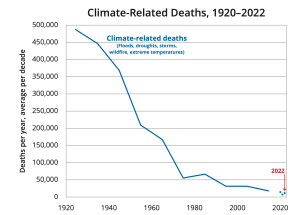
President Biden’s former national climate adviser Gina McCarthy has declared that “climate change is the most significant public-health issue of our time.” She said it in January 2021, the same month when the country had a record death toll from Covid. But even if we ignore the pandemic, she was not even close to being right. If we were to assume that every single heat-related death in the U.S. was caused by climate change (that’s 8,600 deaths a year), along with every single death caused by extreme weather (another 409 people), the toll doesn’t top 10,000. It pales in comparison with the 181,000 people who are killed by cold temperatures, or the 746,000 people who die from cancers. The most significant public-health issue in the U.S. today is cardiovascular disease, which kills 923,000 people a year.
Not only is climate not the big killer of our times, it also isn’t claiming more lives than before — as this graph shows. Globally, a century ago, almost half a million people died each year from storms, floods, droughts, wildfires, and extreme temperatures — what we might think of as weather-related deaths. In the past ten decades, such deaths have dropped by 98 percent, even while the global population has increased massively.
In 2022, fewer than 11,000 people died across the entire world from all these climate-related events. We went from half a million deaths to 11,000. Why? Because we have more resources and better technology, and hence people are more resilient. We are safer than ever.
7. Renewables since 1800: Not Going Net-Zero
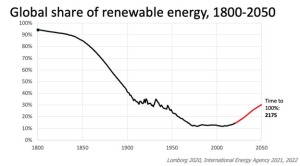
We constantly hear that renewable energies are taking over from fossil fuels, as though all the hard work had been done already and the only thing still needed to stop climate change was a little more political willpower. This is wishful thinking.
The fact is, solar and wind are still capable of meeting only a fraction of global electricity needs. Even with huge subsidies and political support, solar and wind delivered just 10 percent of global electricity in 2021. Heating, transport, and vital industrial processes account for much more energy use than does electricity generation. This means solar and wind deliver just 1.9 percent of the global energy supply. And electricity is the easiest of these components to decarbonize: We haven’t yet made meaningful progress toward greening the remaining four-fifths of global energy.
The most renewable continent is Africa. Half of its energy comes from renewables, almost exclusively wood, dung, and cardboard burned for cooking and heating — which kills about 700,000 people a year in sub-Saharan Africa with indoor air pollution. A billion Africans have little reliable energy because they’re poor. California uses more energy in its pools and hot tubs than all 60 million inhabitants of Tanzania use together. Economic development can move them out of this unenviable position, but it will also mean that Africans use much more fossil fuel.
In its newest report, the International Energy Agency estimates that even implementing all current political promises will make the world only about 30 percent renewable by 2050. An extrapolation suggests that the world will reach 100 percent renewable only by late next century.
It is much more difficult to get rid of fossil fuels than most campaigners will admit. To fulfill the promises made in the Paris climate accords, the United Nations says, annual reduction by 2030 would have to be eleven times what we managed to achieve when the world ground to a halt during the Covid lockdowns. That is hardly realistic.
8. Cost of Going Net-Zero
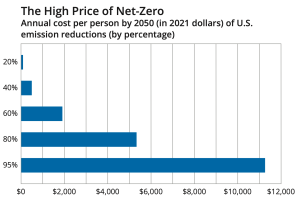
Then there’s the question of how all this can be paid for. Consultancy firm McKinsey has made probably the most comprehensive global overview of the cost of going net-zero. It would be fantastically expensive. Just the additional cost of low-emission assets and infrastructure would be $5.6 trillion annually. That is more than one-third of the global annual tax intake.
If costs of more than a trillion dollars for the U.S., or the same amount for the EU, are not astounding enough, look at emerging-economy India, now the most populous country in the world, which is striving to swiftly eradicate poverty. Going net-zero would cost India a massive 9 percent of GDP each and every year. That is about three-fourths of the total Indian tax intake. Imagining that India would spend most of its available resources to achieve net-zero is just a fantasy. The same is true for sub-Saharan Africa and other developing and emerging economies.
But it’s not as if things are much more achievable in rich countries. One American study found that reducing emissions by 80 percent could cost each American more than $5,000 every year by 2050. The same analysis found that going almost net-zero (say, reducing emissions 95 percent) could double that cost. It seems unlikely that any politicians will get reelected on that ticket, so these policies are doomed to failure.
Glasgow Climate Protesters
Activists symbolically set George Square on fire with an art installation of faux flames and smoke ahead of the U.N. Climate Change Conference in Glasgow, Scotland, October 28, 2021.
Russell Cheyne/Reuters
In Summary
Global warming is real, but it is not the end of the world. Indeed, the world’s only climate economist to win the Nobel Prize in economics estimates that if we do nothing, the cost of climate change will be equivalent to a loss of about 4 percent of GDP by the end of the century.
This is certainly not nothing. But remember that by the end of the century, the U.N. itself, in its middle-of-the-road scenario, estimates that the average person in the world will be about 450 percent as rich as the average person is today.
As I have shown in my peer-reviewed 2020 article in the journal Technological Forecasting and Social Change, the 4 percent reduction means that by the end of the century, instead of being 450 percent as rich, the average person will be “only” 434 percent as rich because of the effects of climate change. This is less good than it could have been — and it is one of the reasons we should tackle the climate problem. But it is certainly not the end of the world. And if the panic means we end up adopting poor climate policies and spending 5 to 10 percent of our GDP on them, we could very well end up worse off overall.
Economic research overwhelmingly shows that the best way to address climate change is not by asking everyone to be colder and poorer. This hardly works in the rich world, and certainly not in the world’s poorer places.
Instead, we need to do what America does best: invest in innovation. Humanity has long relied on innovation to solve big problems. We didn’t solve air pollution by forcing everyone to stop driving but by inventing the catalytic converter, which drastically lowers pollution. We didn’t slash hunger by telling everyone to eat less but through innovations of the third agricultural revolution, which enabled farmers to produce much more food.
Yet innovation in green energy has been neglected as campaigners and “green” corporations have rushed to roll out inefficient technology — and get it subsidized by taxpayers. In 1980 the rich world spent more than eight cents of every $100 of its GDP on R&D in low-carbon technologies. But as climate policies focused on making fossil fuels more expensive, green-research spending was halved to less than four cents of every $100.
Researchers for the Copenhagen Consensus, including three Nobel-laureate economists, have shown that the most effective climate policy possible is to increase green-R&D spending fivefold, to $100 billion per year.
We need to look for breakthroughs across all areas of energy technology, from cheaper solar and wind, coupled with massive and very cheap energy storage, to CO₂ extraction, fusion, second-generation biofuels, next-generation nuclear energy, and many other potential solutions.
This will not just help rich, well-meaning Americans and Europeans to cut emissions a bit, but will get China, India, and Africa on board as well. Climate change will be solved not by making fossil energy unaffordable, but by innovating the price of green technologies downward so that everyone can afford the switch.
To see this article in its entirety and subscribe to others like it, choose to read more.
 Listen Online
Listen Online Watch Online
Watch Online Find a Station in Your Area
Find a Station in Your Area


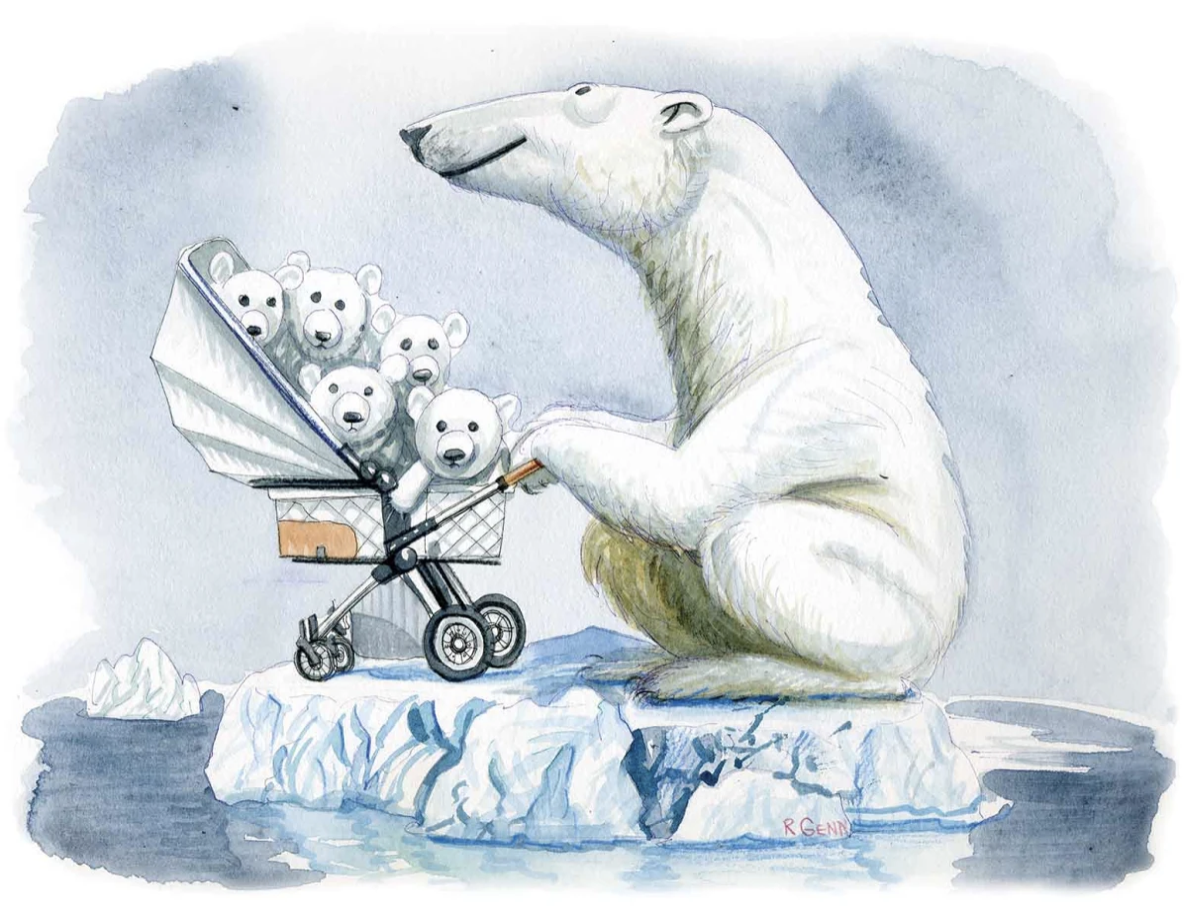







 Listen Now
Listen Now Watch Online
Watch Online
